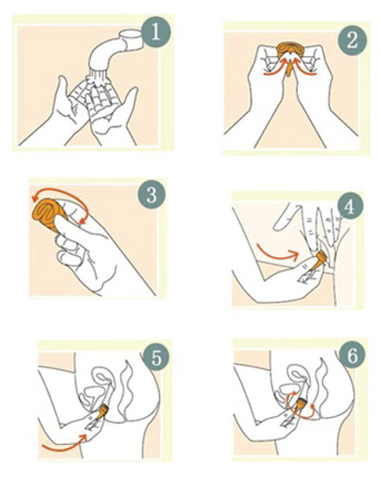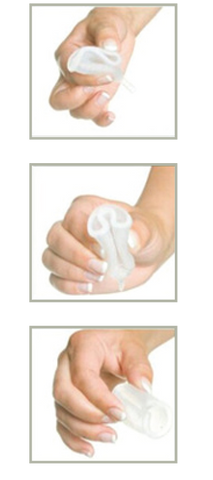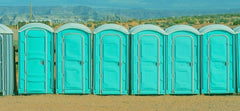By S Mason Dip Nat, Dip Herb, Dip Ayur
Our Confidence Cups are made from Medical Grade Silicone and are a quantum leap from tampons and pads offering many new advantages to traditional women’s sanitary accessories. These reusable menstrual cups are cheaper in the long run, sustainable, eco-friendly, discreet, transportable, hygienic and most of all convenient and easy to use. 1,2
However, like all new advances many have genuine questions and concerns around them.
How do Menstrual Cups Work?
The inside of the vagina is lined with a specialized type of soft, pliable, epithelial tissue, designed to keep the area moist and slightly lubricated. The cells lining it also slough off easily and grow back rapidly. The Confidence Cup makes use of this function to use the vagina’s natural lubrication to seal the lip of the menstrual cup against the vaginal wall to prevent leakage, and the natural lubrication and epithelial cell sloughing makes application easier. 3
Pelvic floor muscles pressing against the vagina also help to keep the menstrual cup in place. 5
Sealed against the vaginal wall and held in place by its muscles, the menstrual cup prevents menstrual blood from escaping and gathers inside the cup, awaiting removal and emptying.
How Much Menstrual Blood Can It Contain?
Our Confidence Cup can hold up to 2 – 3 times more than a tampon depending on the size cup you use. The small size can hold up to 25 milliliters and the large size can hold up to 30 milliliters. The real question may not be how much menstrual blood can it contain, but how many times will it have to be emptied.
This of course depends of the person but given that it holds 2 – 3 times more than a tampon you won't have to worry about increased trips to the bathroom.
How Easy Is It To Insert The Cup And Remove The Cup?

With a little practice,Confidence Cups will soon become a breeze .
Wash your hands thoroughly to remove any possible unwanted pathogens (more on this later). It is recommended to practice inserting the menstrual cup prior to your period and for the unacquainted, start to understand the anatomy of your vagina. If you have inserted tampons before, it is somewhat similar. If you have not, then it is worth getting the feel for where the vagina leads internally. One of the common mistakes people make is trying to push the menstrual cup up, whereas the correct method is to push the menstrual cup almost downwards toward the tail one. This is because the vagina canal (see diagram) is actually slightly angled.
How Do I Fold A Reusable Cup?
 With the Confidence Cup in your hand, make one of the three recommended folds (see diagram). Either squat, sit or stand – but make sure your legs are apart. Gently feel for the opening of the vagina and insert the rim of the Confidence Cup, gently pushing it up and letting it go. It will unfold into a full circle shape. As an extra precaution, you can always carefully slide a finger up beside it to check it has formed the round shape. The Confidence Cup will now remain in place until such time as you choose to remove it. Once you have used the Confidence Cup a few times and are comfortable with it and have fitted the correct size, it will stay in place and you can even engage in sports activities if you so choose to.
With the Confidence Cup in your hand, make one of the three recommended folds (see diagram). Either squat, sit or stand – but make sure your legs are apart. Gently feel for the opening of the vagina and insert the rim of the Confidence Cup, gently pushing it up and letting it go. It will unfold into a full circle shape. As an extra precaution, you can always carefully slide a finger up beside it to check it has formed the round shape. The Confidence Cup will now remain in place until such time as you choose to remove it. Once you have used the Confidence Cup a few times and are comfortable with it and have fitted the correct size, it will stay in place and you can even engage in sports activities if you so choose to.
Removing The Menstrual Cup.
One of the biggest fears around removing the menstrual cup is spillage or that it might be messy.
Given that the Confidence Cup contains menstrual blood and that it is sealed against the side of the vagina, correctly removing it should mean that there is no spillage. The fear of it being messy is can only exist because of inexperience using the menstrual cup.
If you are not at your house, get out the collapsible container ready that the Confidence Cup came in. Wash your hands thoroughly to reduce the chance of passing any pathogen into the vaginal environment. In a squatting or sitting position, gently feel for the stalk of the menstrual cup. DO NOT pull on the stalk. Instead, gently pinch the base of the menstrual cup to change the shape of the rim sealing it against the vaginal side. This will break the seal and allow it to slide out easier. You will feel the seal break as it will be easier to tug downwards. Now you can grasp the stalk, but do so close to the base of the menstrual cup and gently pull it out.
Once out, empty into the toilet, rinse and reinsert. If you are somewhere where a tap is not handy, use the collapsible container. Fill it with water, and after emptying the menstrual cup, place it in the collapsible container, and give it a shake to clean it.
Please, please follow these instructions to avoid the experience that Katie in her blog describes, where she yanked the menstrual cup out by the stalk and in her words “splattering blood all up my bathroom wall.”
The menstrual cup only needs to be sterilised once a day and at the end of your menstrual cycle, and this is as simple as filling the collapsible case with water, placing the menstrual cup in it so it is covered in water, then popping it in the microwave and zapping it for 2 minutes. No pathogens will survive the boiling water and a dose of the microwave radiation.
Is There Anyone Who Should Not Use A Menstrual Cup.
In short no. They are designed for all to use, however there are some conditions where you may want to exercise caution.
Vaginismus
This is a condition where the vaginal muscles go into painful spasm upon contact or penetration. Given the that menstrual cup is only inserted part way up, and is soft enough to work in with the contours of the vagina, it is still possible to use but may take some practice and more relaxation than normal. 4
Uterine Fibroids/Endometriosis
Often fibroids and endometriosis can create referred pain into the vaginal area, making it tender upon penetration. Menstrual cups are ideal for the heavy flow often experienced with fibroids. Using a small dab of natural lubricant will help ease the cup inside the vagina. Once fitted though, unless there is actual tissue inflammation of the side of the vagina wall, the menstrual cup should not be felt as it is soft and pliable enough to hug the contours of the vagina. 5,6
Prolapses Of The Bladder And/Or Uterus
If you have a severe prolapse where surgery is the only option to correct it, chances are menstrual cups may not work as the force of the prolapse may continually push down on the menstrual cup.
Mild prolapses where no actual tissues protrude into the vagina from your internal structures means you can use the menstrual cup as per its normal use. 7
Weak Pelvic Floor Muscles
It’s hard to quantify the strength of the pelvic floor muscles, but typically after multiple childbirths there is a chance these muscles are not as toned as they used to be. A classic sign of weak pelvic floor muscles is urinary incontinence, especially where it occurs with sneezing or coughing.
Where the incontinence is minor the pelvic floor muscles should be strong enough to retain the menstrual cup, remembering also that the menstrual cup creates a seal against the vaginal wall, which helps hold it in place.
Didn’t The NZ Herald And Stuff Print An Article Saying;
'That Menstrual Cups Were Just As Likely To Give You Toxic Shock Syndrome tss?'
The article referenced the British Tabloid, the Daily Mail, which in turn referenced a French study that concluded inserting anything into the vagina and leaving it there for a long period of time may increase the chances of Toxic Shock Syndrome. It also pointed out the Toxic Shock Syndrome only affected about 1 in a million women. You have more chance of being hit by a car. 8
The Journal of Women’s Health concluded the following after doing research on menstrual cups: “… results demonstrate that a (menstrual cup) has no significant health risks and is acceptable to many women without the need for fitting or other medical services.” 9
The vagina has a slightly acidic pH and houses millions of friendly bacteria whose job it is to maintain the health and the internal environment of the vagina. It seems from this authors reading of the literature surrounding vaginal health and years of experience as a natural health practitioner, that for toxic shock syndrome to occur, there needs to be two factors involved. Firstly, the inserted object needs to be in place for an inordinate length of time, beyond that which is sensible, and, secondly, there needs to be an imbalance of the healthy bacteria of the vagina. 10
By sticking with the recommended usage instructions for menstrual cup, the vast majority of people need never worry about Toxic Shock Syndrome.
You have everything to gain from trying and using menstrual cup; saving money, time and having a worry-cycle. Please contact us with any individual questions or concerns. We would love to help you on your journey to easier monthly cycles.
References:
- https://en.wikipedia.org/wiki/Medical_grade_silicone
- https://www.ncbi.nlm.nih.gov/pmc/articles/PMC4884743/?fbclid=IwAR0I-ksolZuhqRzAlrZcfUIjwqE8g0sUwhntj6wG6Xa8TEZrKY-rYqawylU
- https://en.wikipedia.org/wiki/Pelvic_floor
- https://en.wikipedia.org/wiki/Vaginismus
- https://en.wikipedia.org/wiki/Uterine_fibroid
- https://en.wikipedia.org/wiki/Endometriosis
- https://en.wikipedia.org/wiki/Uterine_prolapse
- https://en.wikipedia.org/wiki/Menstrual_cup?fbclid=IwAR1BYGhBAtfe0UcKXQKR5OEd6xydbU6ZvdY-y2rXHqbMUj07XEIwYygLvuQ#Toxic_shock_syndrome
- https://www.ncbi.nlm.nih.gov/pmc/articles/PMC3036176/
- https://en.wikipedia.org/wiki/List_of_microbiota_species_of_the_lower_reproductive_tract_of_women




